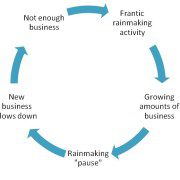Find Your Weekly Minimum
What happens to your business development activity when you get busy? If you’re like many others, you may find that it slips. I’ve had more than a handful of clients who hire me to ramp up their rainmaking, and they succeed — right to the point that they’re so busy they pause and start backsliding.
We’ve all been taught that a bird in the hand is worth two in the bush, and there’s truth to that. I’m no hunter, but we all know intuitively that if you focus exclusively on the bird in hand and ignore all the others, you’ll have to start from scratch when you need to find another bird.
“I’m going to pause for a little while, just til I get this work off my desk.” That’s one of the most dangerous statements you can make. Throw that out too often, and I can almost guarantee that you won’t get the results you want from your rainmaking efforts. You’re likely to end up tired, behind the 8-ball, stressed out, and feeling like a failure. And here’s why…
When you “hit pause”, you’re not pausing at all: you’re just stepping into the feast/famine cycle. In this cycle, you need new business so you start business development activity; you grow your practice, only to slack off when you have substantial new business on your desk and you turn to getting the work done, which causes you to drop back on your rainmaking activity; and the result is that the flow of new business drops and at some point your realize you need more business — and the cycle starts again.
Fortunately, there’s a simple way out to interrupt this cycle. Identify the minimal amount of rainmaker activity you can do and still generate new leads and new referrals.
- You might find that you get referrals and new business from current clients, and so you might decide that, no matter what, you will make time to take one client to lunch each month and to plan a phone call to check in with others once a week. (And if you get significant additional work from current clients, you’re in a great position, because that means that you have an opportunity to engage in business development activity every time you do billable work.)
- You might analyze where your clients have been coming from and discover that your blog is generating a lot of calls that lead to business. If so, you should ensure that you post at least weekly, and you might even investigate hiring someone to help you with SEO or AdWords, to gain additional visibility.
- You might discover that you have an effective follow-up system and that you can expect to get measurable new business after speaking. Develop a system that allows you to send out proposals to speak on a regular basis, and ensure that you speak at least quarterly.
As long as you have a reasonable rationale for your minimal level of rainmaking activity and you stick to it, you’re likely to avoid the feast/famine cycle. You’ll continue to see some variation from time to time, but when you’re strategic and consistent, those swings will be much less significant.
Here’s your checklist for determining your MERA (Minimal Effective Rainmaker Activity):
- Review the sources of your business over the last two years. What activity generated the most business? What generated the least? Be sure to distinguish activity that’s slow yield from activity that’s low yield.
- Set a minimum activity level in the top producers. Calendar whatever it is that you’ve determined you’ll do, and don’t allow yourself to delay, even when you’re busy.
- Delete all other rainmaking activity from your calendar…FOR NOW. This approach is not designed to generate the most business possible. It’s designed to defeat the feast/famine cycle. It contains the seeds for long-term success, but you’ll need to do more in the long run to produce the maximum results.
- Set your date for re-evaluation and don’t get complacent. The only downside to MERA is that you can lull yourself into thinking that any activity is adequate for any circumstance, and that just isn’t true. MERA is only for the times when you’re tempted to press pause.
If you don’t know how to determine what activity is most likely to yield results for you, you’ll have trouble with this task. Building a practice requires you to know what produces results so you can do more of that. If you don’t, we should talk. Schedule a complimentary consultation.




Leave a Reply
Want to join the discussion?Feel free to contribute!